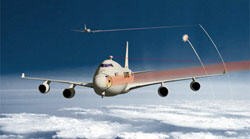Northrop Grumman Uses NI LabVIEW and DIAdem for Rapid Telemetry Data Management
Omar Mussa, Northrop Grumman Space Technology

"Using DIAdem and the DataPlugin architecture, we achieved significant efficiency improvements in handling large datasets and managing our data."
- Omar Mussa, Northrop Grumman Space Technology
The Challenge:
Creating an inexpensive method for quickly locating, organizing, and analyzing binary telemetry data files.
The Solution:
Using NI LabVIEW and DIAdem to generate a custom DataPlugin file and integrating that file with the NI DataMine application.
Northrop Grumman is a leading global defense company and provider of a broad array of technologically advanced solutions in defense electronics, information technology, advanced aircraft, and space technology. We were recently selected by the U.S. Air Force to participate in the development of a revolutionary new ballistic missile defense system, the Airborne Laser (ABL).
The ABL system consists of a laser mounted on a modified Boeing 747. During each second of operation, thousands of telemetry points monitoring the health and status of the system are stored into binary data files. These files grow in both size and number over time. Managing the files so that engineers can efficiently diagnose and report testing events is a difficult problem. We needed a tool that can quickly analyze these files while meeting several demanding specifications. The parsing algorithm must be flexible so that if the message format changes, the program can quickly be adapted to the new system. Test data must be organized so that engineers can easily find test data for months, or even years, after the completion of a particular test. The system must also be able to handle large files (>50 MB) without choking, and it must allow the end user to analyze the data in several ways, using Microsoft Excel, The MathWorks, Inc. Matlab®, or other scripting programs. Finally, the system must be as maintenance-free as possible.
Our schedule and resources did not warrant investing a lot of time developing a suite of custom reporting tools from scratch, so we decided to use the free NI DIAdem DataMine example application that was discussed in the application note Self-Configuring Data Management System Based on LabVIEW and DIAdem. The DataMine application consists of NI LabVIEW executables that interface with a Microsoft Access database used to store and file metadata such as test time and file name, along with the file path to the raw data files. The DataMine application also comes with scripts and graphical user interfaces (GUIs) that can run in DIAdem to search and extract metadata and raw test data. Using the DataMine application, our development effort was limited to parsing the file correctly in the DataPlugin. (DataPlugins are Visual Basic scripts that are registered with Uniform Storage Interface, or USI, and provide data translation services, allowing access to customer-defined file formats.) Using this system, we eliminated the need to build custom GUIs and reports altogether, saving hundreds of design, code, and test time man hours.
The flexibility of the DataPlugin architecture is a key component of our solution. As the format of the data we parse changes, we can easily adapt our code to support these changes. Additionally, some of the telemetry fields we parse are actually status bytes that require further parsing in order to isolate the useful information into a data channel. Our test data files are also mixed between ASCII text timestamps and raw binary data. All of these issues are very easy to accommodate within the DataPlugin architecture.
Data formatting is also important to us. We use the DataPlugin to populate the channel properties, such as “units,” as the files are parsed, making it easier for the engineers to analyze the data. We also scale the values from within the parser so that other scripts or reports that read the data will not require further processing of the raw data once it has been parsed by the DataPlugin. This gives us a lot of flexibility and scalability for future applications.
After generating the DataPlugin, we were pleased with how easy it was to integrate with the DataMine application and DIAdem. To register our DataPlugin with DIAdem was a simple process, and DIAdem generated a registration (.uri) file that can be used to install the DataPlugin on other machines. Additionally, the DataPlugin can be associated with a file extension and automatically used to import data of a particular type. We use this feature to prevent bad data from being imported into the system, giving the engineers control over which files are managed via the file names.
Using DIAdem and the DataPlugin architecture, we achieved significant efficiency improvements in handling large datasets and managing our data. This application has become the focal point of our analysis effort, and we are pleased with both the results and the low cost of the project.
Matlab® is a registered trademark of The MathWorks, Inc.
Author Information:
Omar Mussa
Northrop Grumman Space Technology
One Northrop Grumman Avenue
El Segundo, CA 90245
Tel: 310-812-0203
omar.mussa@ngc.com

